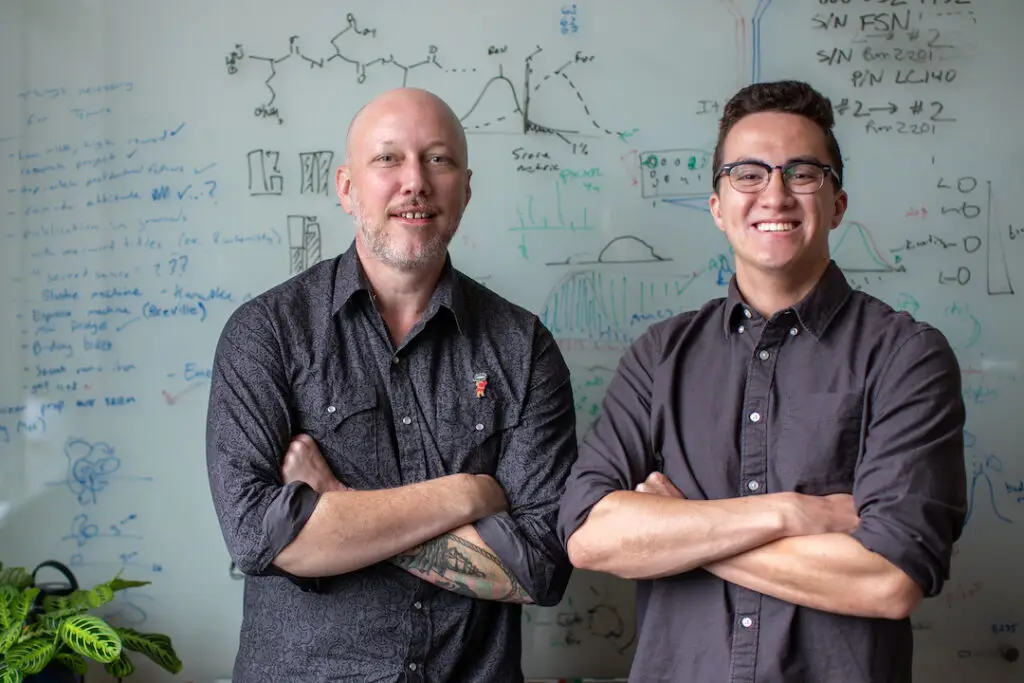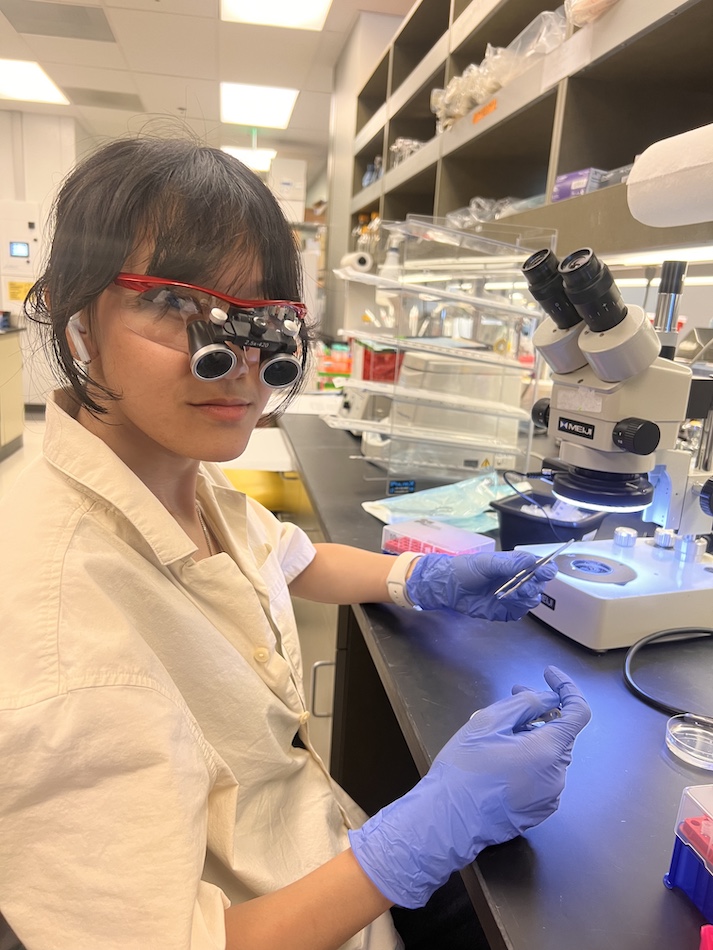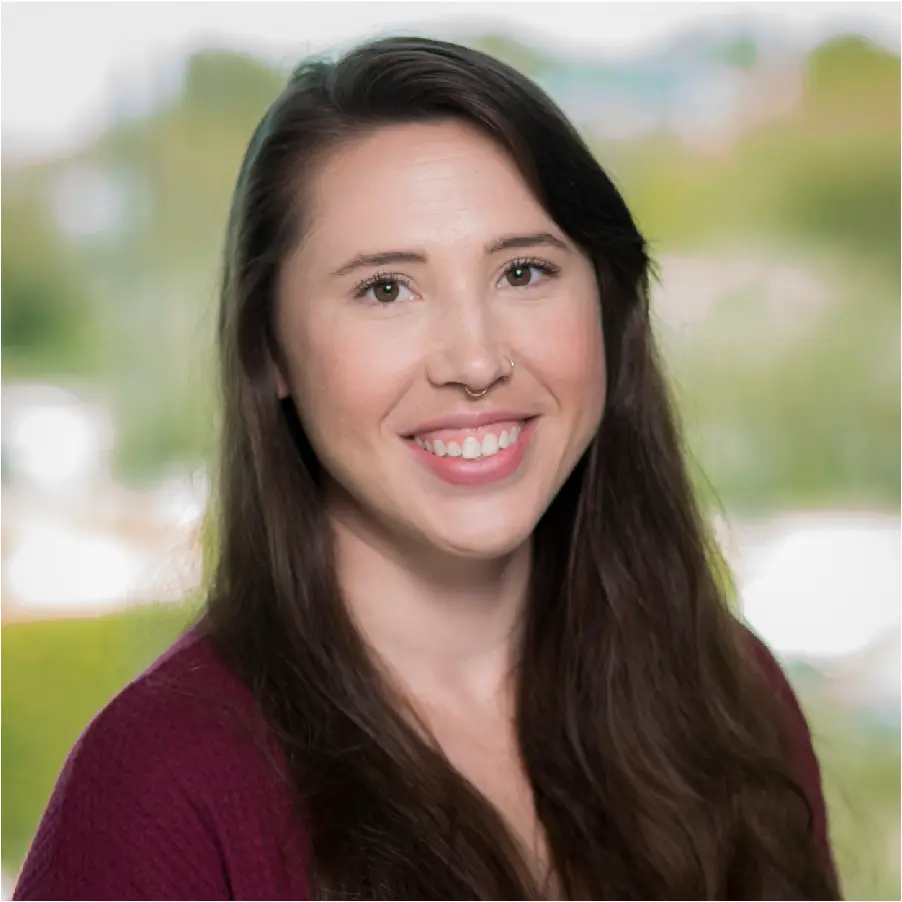Scientific research can be rough. Machines break down. Experiments fail.
Good scientists take a minute, take a breath, and make a new plan.
In 2021, Patrick Kennedy was working toward his undergraduate degree at UC San Diego. “I’d done an internship at a local biotech company, but I knew I wanted academic research experience. My goal was to go to graduate school and get my Ph.D.,” says Kennedy.
One day, Kennedy ran across a news article about chemist Samuel Myers, Ph.D., joining the faculty at La Jolla Institute for Immunology (LJI). So he emailed Myers. “He asked me to come by LJI. We discussed potential projects, and he seemed like someone I’d really enjoy working for and doing science with.”
Kennedy soon joined Myers as a part-time intern, making him the first member of the Myers’ Laboratory for Immunochemical Circuits.
Myers had just moved to San Diego after a three-year term as a Research Scientist at the Broad Institute. As a new LJI Assistant Professor, Myers’ first task was to set up his laboratory. His lab would be the lone chemistry-focused laboratory at LJI, which came with its own challenges. [Read article: How to build a lab]
Meanwhile, supply-line problems forced Kennedy to get scrappy as he tried to hunt down research tools. Still, Kennedy knew he had a very rare, very valuable opportunity. “Not many people get to work with their P.I. [Principal Investigator] one-on-one,” says Kennedy. “But because I was the only lab member, I was afforded that opportunity. I’m thankful for that.”
It wasn’t long before graduate students and postdoctoral researchers began joining the new lab. As an intern, Kennedy assisted these lab members with experimental work and analysis. The job gave Kennedy a chance to learn from experts in immunology, gene editing, and mass spectrometry—a key tool in the Myers Lab.
The lab was up and running. Things were looking good.

The bad news
Kennedy was getting ready to graduate from UC San Diego when something unexpected happened. Kennedy found out he hadn’t gotten into any of the graduate programs he’d applied for.
“That wasn’t a fun thing to go through—to get all those rejection emails,” says Kennedy.
But he had no time to wallow. “Sam and I discussed it, and he gave me the option of joining the lab full time as a research technician. From there, he and I set out with a goal: I’d work really hard for the next year or two. Then, when the time came, I’d reapply and see what happens.”
That’s when the research got laser-focused.
A new way to study immune cells
Myers studies signaling pathways in cells. He wants to know how chemical modifications prepare immune cells to fight viruses, cancers, and other threats.
As an LJI Research Technician, Kennedy began working on a new research protocol to help scientists study these chemical modifications. He worked closely with Myers to devise a rapid method for studying what happens when molecules called phosphate groups are coupled or removed from proteins within immune cells.
Phosphate groups direct how proteins do their jobs within cells. They are added to proteins in a process called phosphorylation. In T cells, certain proteins rely on phosphorylation during a process called T cell activation, which is when a T cell prepares to fight cancers or pathogens.
Myers and Kennedy wanted to know—could they develop a faster way to study the effects of specific protein phosphorylation events? Putting this puzzle together could one day help scientists manipulate the T cell activation process to help patients with cancers or dangerous infections.
Before now, studying phosphorylation was a slow process. Scientists could only analyze around a dozen phosphorylation sites at a time. Kennedy’s research, published in Nature Methods, changes the game. Researchers can now investigate over 10,000 phosphorylation sites at once by combining techniques in gene editing with next-generation sequencing, guided by mass spectrometry.
“This method basically creates an entire new kind of world of experiments that people can do,” says Myers. [Read article: Researchers reveal how protein modifications power T cells]
A team effort
Working in the Myers Lab gave Kennedy more than new technical skills. “You could go many places to learn a lot of the hands-on stuff,” says Kennedy. “But I really appreciated being taught how to ask scientific questions—and how scientific problems are solved.”
Kennedy had proven he could spearhead important projects. He knew he was getting closer to applying again to graduate programs. Most of his colleagues had been through grad school applications and interviews, and they stepped up to help him prepare.
Lab members went over potential interview questions with Kennedy. Myers and several colleagues also helped him practice a presentation about his work. They watched the hour-long presentation over and over again and offered feedback on Kennedy’s slides and scientific explanations. Then Myers put Kennedy in front of an even bigger audience.
“One of the coolest things—and I was really thankful for this—is that I got the chance to speak at an LJI internal seminar,” says Kennedy. “That was my first-ever ‘big talk,’ and it really helped to do that in front of the whole institute and to get feedback from peers.”
Shortly after his internal seminar, Kennedy attended a scientific conference in Washington D.C., where he gave his talk to an even larger scientific audience. Kennedy says the actual event is a blur. Adrenaline was flowing. But he remembers looking out at the crowd and feeling confident.
In January 2024, Kennedy was invited to visit UC San Francisco to interview for the university’s Biomedical Sciences graduate program—the same program Myers had attended for graduate school. The interviews lasted an entire week. “It was a high-pressure situation, but it felt almost natural since everyone in my lab had helped me prepare in one way or another,” Kennedy says.
The good news
Kennedy was waiting to hear back from UC San Francisco when something unfortunate happened: he caught COVID.
He was sick at home when the email came through. He’d gotten into graduate school.
“I wanted to celebrate but I couldn’t!” says Kennedy. “After a few days, I went into work and the first thing I did was tell them the news. Everyone just kind of ran out and gave me hugs. It really made me appreciate how much everyone cared about me as a person. That was one of my favorite moments.”
Now Kennedy is getting ready to leave town. He’ll be moving up to San Francisco in August. “It’s hard not to get sentimental,” says Kennedy.
“I’m going to miss everything at LJI, but the things that I probably am going to miss the most are the relationships that I’ve gained,” he says. “I view a lot of my coworkers as really good friends.”


